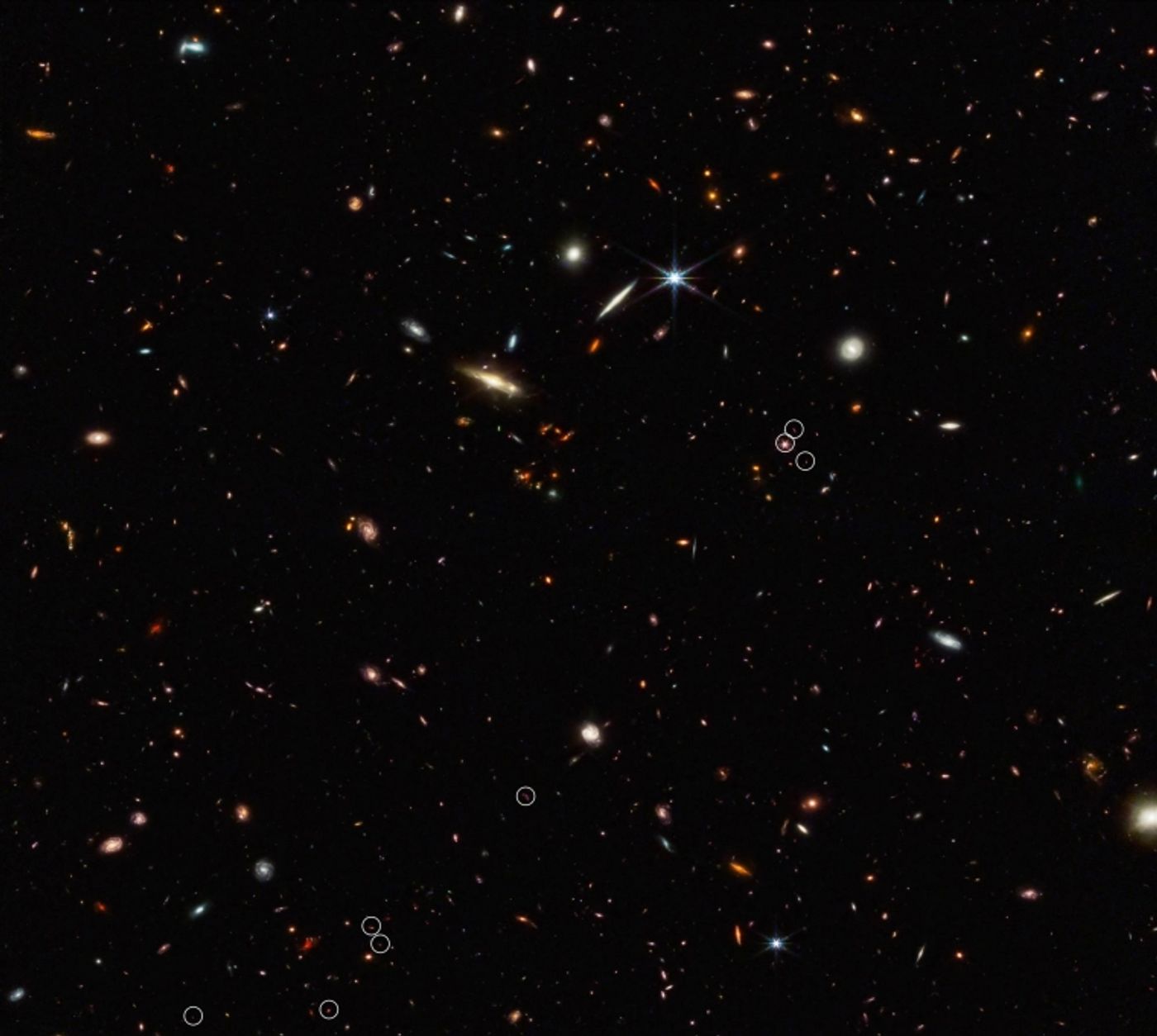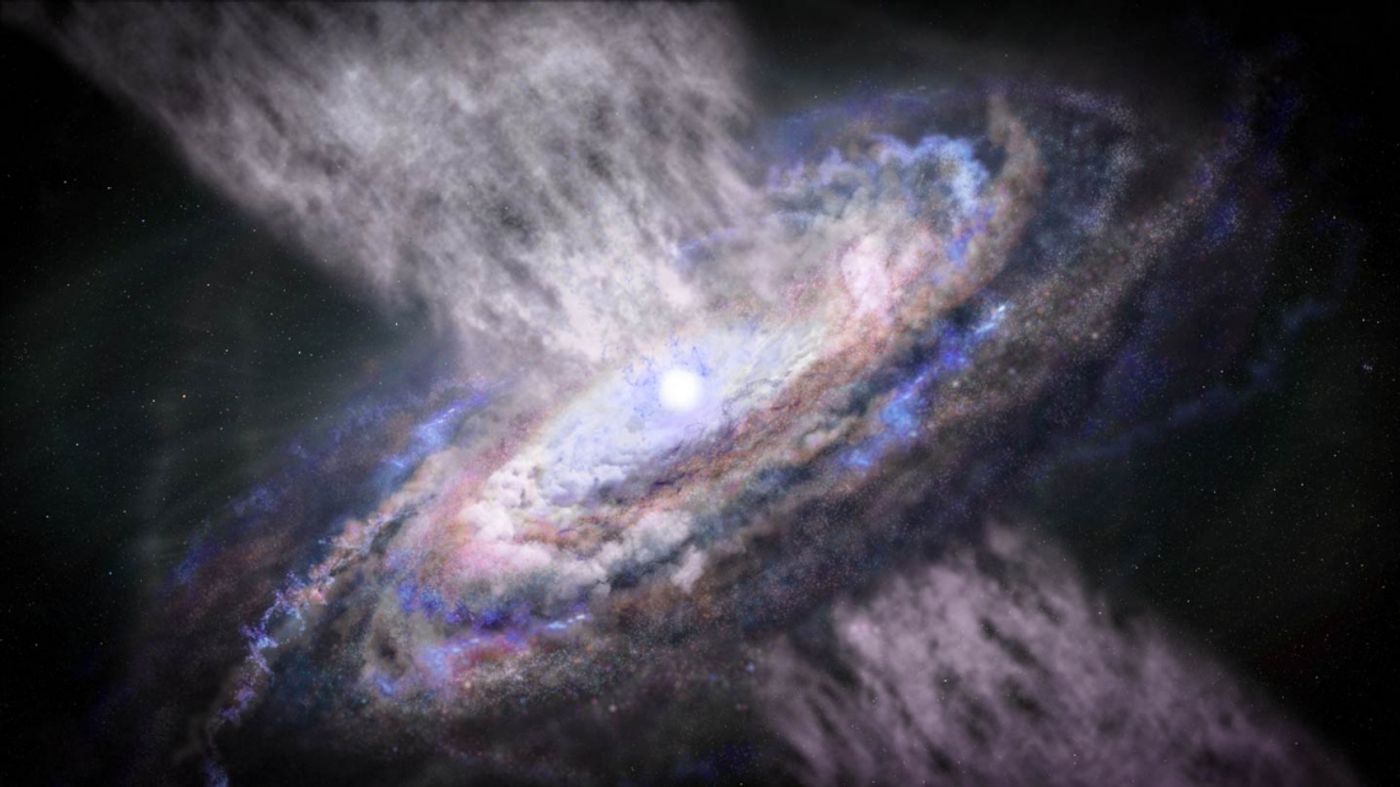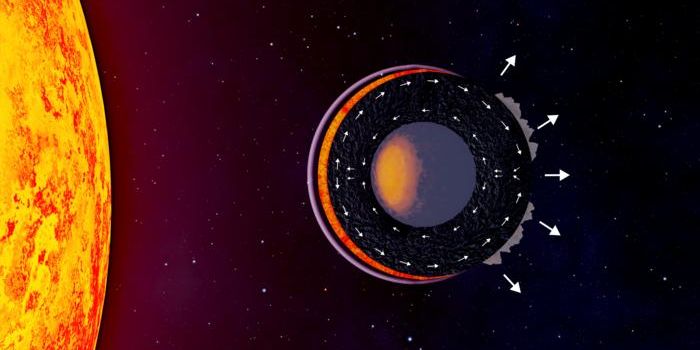NASA Webb Discovers Early Universe Galaxy Structure
A team of researchers led by the University of Arizona recently used NASA’s James Webb Space Telescope (JWST) to examine a group of 10 galaxies that existed only 830 million years after the Big Bang, or just under 13 billion years ago. The 10-galaxy structure is stretched in a filament-like line almost 3 billion light-years across and was found to be orbiting a bright quasar, which is a galaxy that possesses a supermassive black hole at its center. The finding was so profound that it had to be split into two separate papers, both published in The Astrophysical Journal Letters, and holds the potential to help scientists better understand how such filament-like structures evolve over time.
Deep galaxy field image taken by Webb's Near-Infrared Camera (NIRCam) displaying 10 distant galaxies (white circles) in a diagonal, filament-like line that spans almost 3 billion light-years across. (Credit: NASA, ESA, CSA, Feige Wang/University of Arizona and Joseph DePasquale/STScI)
"This is one of the earliest filamentary structures that people have ever found associated with a distant quasar," said Dr. Feige Wang, who is an assistant research professor at the Steward Observatory at the University of Arizona (UArizona) and lead author of the first study.
While deep space images might depict galaxies as being randomly located throughout the cosmos, the truth is they are bunched into clusters or groups connected into filamentary structures, with our Mily Way Galaxy being a member of the Local Group comprised of over 30 galaxies.
What makes this discovery unique is this is the first filament structure discovered at such a young age of the universe, which is approximately six percent of its present age, and was discovered as part of the UArizona-led ASPIRE project whose principal investigator is Dr. Wang.
"The last two decades of cosmology research have given us a robust understanding of how the cosmic web forms and evolves," said Dr. Joseph Hennawi, who is a professor in the Department of Physics at the University of California, Santa Barbara, and a co-author on the first study. "ASPIRE aims to understand how to embed the emergence of the earliest massive black holes into our current story of cosmic structure formation."
The second study examined the characteristics of eight quasars in the early universe, also less than one billion years after the Big Bang, with the team finding the sizes of the supermassive black holes at their centers ranged from 600 million to 2 billion solar masses. Scientists aspire to learn how such large structures formed at such a young age of the universe, which Dr. Wang said two criteria need to be met.
Artist's illustration of a quasar, which are some of the most luminous objects in the cosmos. The energy discharged by a quasar's supermassive black hole as it accretes mass from its surroundings is largely considered to be the primary reason in reducing the growth of large galaxies. (Credit: Space Telescope Science Institute)
"First, you need to start growing from a massive 'seed' black hole," said Dr. Wang, who is also a co-author on the second study. "Two, even if this seed starts with a mass equivalent of a thousand suns, it needs to accrete a million times more matter at the maximum possible rate in a relatively short time, because our observations caught it at a time when it was still very young."
The JWST observations also found the most comprehensive proof how young supermassive black holes influence the formation of stars within those same galaxies due to the powerful “winds” they exert, even though supermassive black holes are primarily known for accreting matter. This finding is significant since stars form in clouds of gas and dust, which are typically very cold. However, the immense amounts of energy from the black holes winds can result in suppression of a star’s formation, according to Dr. Jinyi Yang, who is an assistant research professor at Steward, and lead author of the second study.
"Such winds have been observed in the nearby universe but have never been directly observed this early in the universe, in the Epoch of Reionization," said Dr. Yang. "The scale of the wind is related to the structure of the quasar. In the Webb observations, we are seeing that such winds extend throughout an entire galaxy, affecting its evolution."
What new discoveries will scientists make about galaxies and supermassive black holes that existed in the early universe in the coming years and decades? Only time will tell, and this is why we science!
Sources: EurekAlert!, NASA, EarthSky, University of Arizona News, The Astrophysical Journal Letters, NASA Goddard Space Flight Center, Space Telescope Science Institute, The Astrophysical Journal Letters (1), NASA (1), Inverse
As always, keep doing science & keep looking up!










